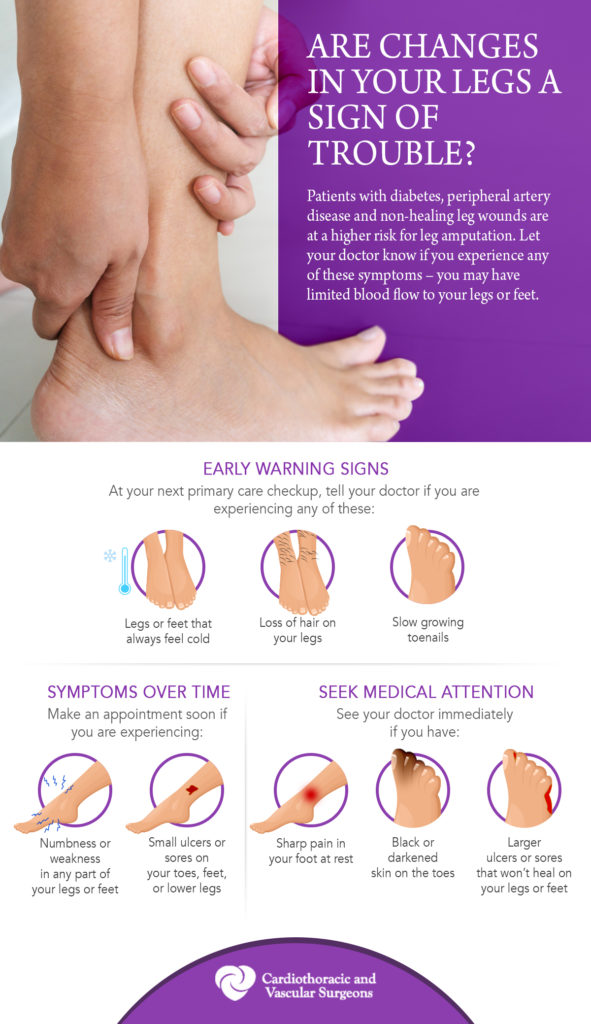A wound or ulcer that will not heal after five to eight weeks of treatment is considered non-healing. These wounds can be painful and frustrating to manage. Here at CTVS, we work with your care providers and do everything medically possible to help wound healing and avoid amputation when a foot wound or leg wound won’t heal.
Symptoms of a non-healing wound:
- Pain at the site or around the wound
- Redness or swelling that spreads out from the wound
- Darker color around the edges
- Warmth at or around the site of the wound
- Pus leaking, draining, or weeping from the wound
- Bad odor or smell at the wound site
Why is my foot or leg ulcer not healing?
There are many reasons your body may not be able to heal your wound. Most chronic wounds can be categorized as one of the following:
- Diabetic foot and leg ulcers: These ulcers result from poor blood sugar control and reduced blood flow, which impair the body’s ability to heal minor injuries and infections.
- Venous or arterial ulcers: Venous ulcers are caused by poor blood flow in the veins, while arterial ulcers are caused by inadequate blood supply to the affected area due to blocked arteries. Both conditions can lead to chronic, non-healing wounds.
- Pressure ulcers: Also known as bedsores, these ulcers occur from prolonged pressure on the skin, typically in those with limited mobility. A lack of blood flow to the affected area can cause tissue damage and delayed healing.
Other factors that can increase your risk of developing a non-healing wound include age, certain blood-thinning medications and a history of certain autoimmune diseases.
We will see you in the clinic to determine what type of ulcer you have and discuss possible treatment options with you before proceeding with next steps.
How long should a foot wound take to heal?
The amount of time it should take for a foot wound to heal can depend on the type of wound, sore or ulcer you have, as well as whether or not you are experiencing any additional complications. While it can take up to around 3 months for some types of foot wounds to fully heal, you should start to see some progress within 4 to 6 weeks. If your wound is not healing at all after this period of time, schedule an appointment with our amputation prevention specialists for a comprehensive diagnosis and personalized treatment plan.
What do I do when a wound or sore won’t heal?
When a wound or sore doesn’t heal in around 4 to 6 weeks, seek medical assistance from our specialists at CTVS. Fortunately, there are many treatments available, including non-surgical therapies and minimally invasive techniques to preserve the limb, prevent amputation, promote the healing of wounds and improve circulation.
The most effective treatment strategy for a wound that won’t heal will depend on your specific circumstances. However, there are some general minimally invasive therapies that are often used to treat a wound that won’t heal including:
- Debridement: The removal of dead or damaged tissue from a wound to promote healing and prevent infection.
- Compression therapy: Using compression socks or bandages can help to improve blood circulation and reduce swelling in the affected area, which can aid in the healing of chronic wounds.
- Topical treatments: Specialized wound care products such as antimicrobial ointments, growth factor creams or hydrocolloid dressings can be used to protect the wound and promote healing.
- Endovenous laser therapy (EVLT): Laser energy can be used to treat varicose veins, which can improve blood flow and help venous ulcers or sores heal.
Our vascular experts will work closely with your care team to ensure proper management of your wound.
When do I seek immediate medical attention?
- Early signs of a threatened extremity: If your legs or feet are feeling cooler in temperature, you notice loss of hair on your legs, or have slow growing toenails
- Progressive signs of a threatened extremity: If you begin to develop numbness, weakness, or small ulcers or sores on your toes, feet, or lower legs
- Severe signs of a threatened extremity: You should schedule an urgent appointment as soon as possible if you have sharp pain in your foot at rest, black/darkened toes, or severe toe, foot, or leg ulcers or sores that won’t heal
For more information, contact our Limb Preservation and Amputation Prevention Program Director Jamie Beffort, RN at (512) 323-5873.
Written by: Jeffrey Apple, MD | Last Reviewed 30 Aug 2024
Telephone No.512-459-8753

